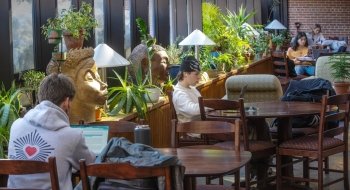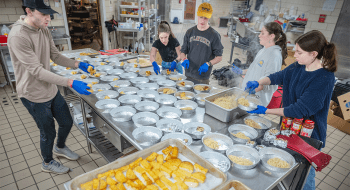
Leading the Trek Into Rhino Conservancy
“Shhhh…move this way and look there,” whispered Rianto, a ranger with Borana Conservancy in Laikipia, Kenya. He was pointing to Linda, a 10-year-old black rhinoceros.
“We have to be careful that we don’t make much noise and hope that the wind doesn’t change. Kifarus (rhinos) have really good smell and hearing, but their eyesight is very poor,” he said quietly.
We hid behind a bush and admired the sight of Linda and Sam, a newborn black rhino calf, Linda’s first birth, a very important milestone in her life.
Located under the volcanic majesty and allure of Mt. Kenya, Africa’s second tallest peak, Laikipia is home to over 50 percent of Kenya’s black rhino population and over 70 percent of its white rhino population. Laikipia is also home to the greatest density of wildlife in Kenya and serves as a successful conservation model throughout Africa. While the rhino conservation in Laikipia has had some success, the growing population needs more space to grow.
Linda’s prospects of survival look good; however, the reality for the future of Kenya’s wildlife is far from good. In the last 40 years, Kenya has lost nearly 70 percent of its large mammals. This loss has not only been catastrophic to existing ecosystems, but also robs future generations from studying and enjoying the wildlife of the continent.
Raised in the middle of Tanzania’s Serengeti National Park, I had a different childhood from most. At a young age, I was immersed in my parents’ careers in conservation, tourism, and environmental education, which nurtured my own love of nature and respect for the people devoted to protecting wildlife in Africa.
I attended St. Lawrence to study conservation biology, graduated in 2010, and for the last six years, I have been working as a guide for the cycle vacation company Trek Travel. I’m passionate about outdoor adventure and sharing beautiful places with people by bicycle and by foot.
While watching rhinos in the Borana Conservancy, I started to imagine a way to combine my passions—conservation and travel—by inviting others to join me in what I began calling Adventure for Rhinos, a 12-day, multi-sport “adventure safari” in support of The Rhino Revival Fund.
The Rhino Revival Fund is managed by Laikipia Wildlife Forum (LWF), a 20,000 strong membership conservation network and nonprofit organization in Laikipia, Kenya. LWF’s executive director is Peter Hetz (yep, you guessed it, my dad), former director of the St. Lawrence Kenya Program in the early 1980s. LWF continues to have strong ties to the Kenya Program and host students, introducing them to the issues of natural resource management in Laikipia.
The LWF has been involved in rhino conservation since its inception in 1992, and, in collaboration with Laikipia’s natural resources stakeholders, LF is supervising a study to expand rhino territory. The Adventure for Rhinos tour is my way to help realize the expansion of rhino habitat and protect the endangered black and white rhinos.
For the residents of Laikipia, rhino conservation means more than just protecting these majestic animals. It is both a sign of respect for this iconic native species and one part of a more comprehensive wildlife conservation and biodiversity conservation.
For travelers, the Adventure for Rhinos does that and more: the money raised through the trip will also support the local economies of communities on the front lines of critical environmental stewardship.
For me, it is also a personal initiative to support something I love. And for anyone who would like to join me, it is an exceptional opportunity to participate in the conservation of one of the most iconic of our endangered species.



